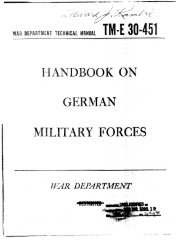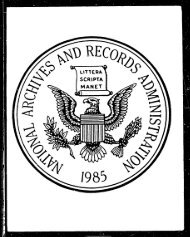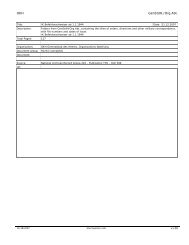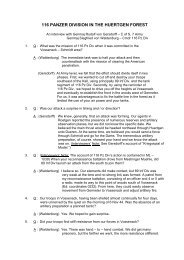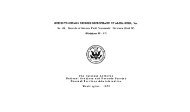D. Firms and Contractsa) Firms5k» Definition, Origin and Development of OT FirmsThe status of a firm in the OT is fundamentally similar to thatof a unit or individual in the Armed Forces of the Reich. Whethersuch a firm applied of its own accord for enrolment as an OT-Firmor whether it was "abgestellt fur OT" (conscripted for the OT), itcontracted itself to carry out construction under OT administration,just as a soldier, by taking the oath, contracts himself to ArmyService. Once enrolled, the firm is designated "OT Einheit"(OT Unit), and the term "Einheit" became, as far as OT isconcerned, synonymous with a building or construction firm contractedto it.The Einheit is expected to operate as a self-contained unit,<strong>com</strong>posed of a clerical and technical staff, possessing the skill andequipment necessary to direct and execute the construction tasksassigned to it. It is also expected, if the situation demands,to convert itself from a static unit working on a <strong>com</strong>parativelylong term building progranme of fortifications, depots and so forth,to a mobile unit <strong>com</strong>bining the functions of army signals andengineer units which restore rear <strong>com</strong>munications. As a unit, it isfurthermore expected to abide by, and to confirm with the regulationsof the OT Central HQ in BERLIN concerning the daily routine of itsown personnel and their relationship to the rest of the OT personnel.The supervision of these firms is the function of Oberbauleitungenwhich are the administrative headquarters in the basic constructionsectors. It must be stressed at this point that the Oberbauleitungis the only direct link between a firm and the OT administration.Any request by a firm requiring action by a higher OT echelon hasto go through the Oberbauleitung controlling the particular sectorin which the firm operates.Regulation of the status of OT-fims was not only a gradualprocess, but also differed considerably in different localities, forexample, the methods employed in France varied from those practisedin Russia. At first, when the OT was organised by Fritz TODTin the spring of 1938, it was created for the one and specificpurpose of <strong>com</strong>pleting the Siegried Line or West Wall, In spiteof the vast proportions of this project, there was considerableuniformity in the type of work that had to be performed whichfacilitated regulation by the OT. Bonuses for speedy and efficientwork were offered by the government, and the patriotic aspect wasduly stressed by the Nazi press. Consequently, enough largebuilding firms offered their services so as to put the entireconstruction on a voluntary basis. (The individual firms even drewlots for the location of their particular building sector).Nor is there any basis later for assuming that firms in any largenumbers became so reluctant to work for the OT as to make massconscription of such concerns necessary. This willingness is dueto the attractive profits obtainable from OT contracts. The onlypossible instance of such reluctance occurred in late 1943 whena large number of firms had to be mobilised for the Russian winterCampaign.From mid-year 1938 until about May 1942, OT firms, backed bythe Reich construction industry, practically ran the OT, and it isonly the unfavourable development of the military situation whichstrengthened the grip of centralized governmental administration- 53
at the expense of the "private <strong>com</strong>mercial building interests. AroundMay 1942, the OTZ, having taken over control of the OT from theGeneral Inspektor ftir das deutsche Strassenwesen (autumn of 1941)»began to issue uniform regulations in respect to OT firms. As i t is ,the Wirtschaftsgruppe Bauindustrie (Economic Group : ConstructionIndustry) and the Reichsinnungsverband des Bauhandwerks (NationalGuild of Building Craftsmen) probably stil l have enough influencein tfos OTZ (now Amt Bau - OTZ) to restrain the government frommaking life unduly unpleasant for their member-firms in the OT.(See Chart 8).Although the main problem of the OT-firm was that of manpower,it also faced a shortage of transportation fuel, lack of sufficientand serviceable equipment and spare parts and, more recently, lackof material due to damage to the <strong>com</strong>munication system by Alliedair-raids. Those difficulties resulted in <strong>com</strong>petition amongst thefirms for manpower, transportation, equipment and material. Nor wasall such <strong>com</strong>petition or even an appreciable part of it open andabove-board. In Prance for example, German and French officials werebribed to procure manpower and the workers themselves were bribed tochange anployment. French sub-contractors who employed Frenchworkers were offered premiums. Building assignments of favouredfirms were given an unwarranted priority rating by the local OTofficials. Conversely, material, manpower, equipment and transportationwere withheld or withdrawn on some pretext from firms with lessfortunate connections. TheOT firm is expected to keep at all timesa minimum of German supervisory personnel and serviceable equipment.Should either drop below the minimum, the firm may find itself inthe position of not being able to obtain foreign manpower from its<strong>com</strong>petent OBL. In this struggle for manpower and supplies, it isthe small firms which go under first. Unable to meet OT'sminimum TO/WE requirements in respect to German technical assistantson their staff, and the TS/WES in respect to equipment, they are<strong>com</strong>pelled - provided they remained in the OT - to choose one oftwo courses. One is to consolidate with other firms and fomn anArbeitsgemeinschaft (Working Combine) <strong>com</strong>monly abbreviated Arge;the other to descend to the 3tatus of sub-contractor to a largerfirm, thus avoiding final responsibility, but on the other handmissing the larger profits of the main contractor (four percentas against six percent). As sub-contractors, OT-Firms can at thesame time form part of an Arge, in which event a single maincontractormay control a <strong>com</strong>bine of sub-contractor3.The evacuation of the OT fromEGW and other parts of Europe intoGermany (summer and autumn of 1944) has resulted in the tighteningof central control in regard to the allotment of manpower to theindividual OT firms. A German construction firm at the presenttime in the Reich i s more than ever regarded as a unit of a regimentedorganization : if, because of lack of <strong>com</strong>petent staff personnel, itlags behind schedule in the performance of its mission, reinforcementsfor its supervisory staff are assigned to it by the OT authorities.Equipment is now similarly pooled. On the other hand the individualOT firm, at present operating within the Reich, has no authorityto recruit its own manpower.55 • Organization of OT firms (See Chart 11)Within the framework of the OT, the internal administration ofthe individual OT firms is made uniform and standardised by means ofpreliminary instructions issued by Wirtschaftsgruppe Bauindustrie tofirms entering the OT. As far as the personnel of an OT firm isconcerned, a distinction is made between Stammarbeiter (German- 5.4
- Page 1 and 2:
IR5/f!lR-0T/5/4SHRnDBOOK OF THEDRcn
- Page 3 and 4:
GE R MAN YOT EINSATZGRUPPEN, AUTUMN
- Page 5 and 6:
TABLE OP CONTENTS(See also LIST OP
- Page 7 and 8:
4a. OrganizSferiy %f Sfciw t>T& ^ ^
- Page 9 and 10:
Page35. "Current Organization" Eins
- Page 11 and 12:
155» Miscellaneous Deductions and
- Page 13 and 14: To-day PT is indispensable in any p
- Page 15 and 16: UNCLASS13* The two "basic types 6_
- Page 17 and 18: of control over its plans, which we
- Page 19 and 20: OT units was that of Bautrupps (Con
- Page 21 and 22: __ n be committed to work by order
- Page 23 and 24: 11. OT Construction Activities 1942
- Page 25 and 26: In case of Allied landings. In the
- Page 27 and 28: Factors militating against complete
- Page 29 and 30: 1* Rationalization^ on a nation wid
- Page 31 and 32: The project itself cannot be accept
- Page 33 and 34: areas within the Reich; (3) Einsatz
- Page 35 and 36: has the final responsibility for me
- Page 37 and 38: Matters of policy, as decided upon
- Page 39 and 40: with the Wehrmacht and with civil a
- Page 41 and 42: which do the actual work. This is o
- Page 43 and 44: adjacent construction sites are gro
- Page 45 and 46: Amt Bau-OTZ.The second ia the auton
- Page 47 and 48: are to be employed in tha execution
- Page 49 and 50: "Current Organization" Bauleitung (
- Page 51 and 52: Former Hauptabteilungen in OTZ have
- Page 53 and 54: (SS Liaison Officer) are the follow
- Page 55 and 56: y the Array for the construction of
- Page 57 and 58: fortresses stretch over its entire
- Page 59 and 60: (Eastern Wall) in April 1943* At on
- Page 61 and 62: obviously would also have the same
- Page 63: Consequently ten lype A emplacement
- Page 67 and 68: eside those of feeding and billetin
- Page 69 and 70: 57* Construction Programme, Materia
- Page 71 and 72: Italian firms arid the workers is c
- Page 73 and 74: "The large scale construction work
- Page 75 and 76: Diplom - Ingenieur "* Paul ANDORY,
- Page 77 and 78: Para. 7 ~ CompensationCompensation
- Page 79 and 80: Para* 16 - Text of the ContractThe
- Page 81 and 82: m tag » * u »"5. For ascertaining
- Page 83 and 84: - Delivery of Building MaterialThe
- Page 85 and 86: prior consent of the HU. Any assign
- Page 87 and 88: ecause of Allied propaganda and the
- Page 89 and 90: all replacement parts of machine we
- Page 91 and 92: served only as a general directive.
- Page 93 and 94: The transport organizations forking
- Page 95 and 96: outside the "boundaries of the Reic
- Page 97 and 98: d) Health and Medical Services77. M
- Page 99 and 100: tfhTheading "identifying scars or w
- Page 101 and 102: example, units of the Feldgendanaer
- Page 103 and 104: set up within the region of each Ar
- Page 105 and 106: Sc^al Festungspionier stab, (Portre
- Page 107 and 108: Refer at (Sub Unit) BII1 : Hochbau,
- Page 109 and 110: 2. Although the agencies are subord
- Page 111 and 112: Emergency Measures1. In case of imm
- Page 113 and 114: The interests of the OT firms as an
- Page 115 and 116:
of the OBL cuts across two or more
- Page 117 and 118:
The following captured document, he
- Page 119 and 120:
sche Nothilfe - Technical Tanarfien
- Page 121 and 122:
Chef de¥iflitfSItverwaltung, Haupt
- Page 123 and 124:
corresponding in area to the DHL's.
- Page 125 and 126:
ij Feldpoli^ei (commonly abbreviate
- Page 127 and 128:
erNSKK Verbindungsf&hrer des Transp
- Page 129 and 130:
, _ .-^^-^^-^sson of aDienstbuch (P
- Page 131 and 132:
ar T—all phases of OT operation.
- Page 133 and 134:
B. Classicioation of Personnela) Ge
- Page 135 and 136:
Control during working hours - unde
- Page 137 and 138:
ii . Betriebsftihrer (Finn Manager)
- Page 139 and 140:
vii,obhoer*ed. In the performance o
- Page 141 and 142:
were supposed to b« numbered conse
- Page 143 and 144:
In the autumn of 192*4, co-operatio
- Page 145 and 146:
with the French Betreuungftthrer me
- Page 147 and 148:
C; Training.129. Military Training.
- Page 149 and 150:
Russians also received this trainin
- Page 151 and 152:
NCO in OT - Dienst Unifom wearing M
- Page 153 and 154:
only distinguishing feature being t
- Page 155 and 156:
Dr. Pritz Todt Ehrennadel in Gold (
- Page 157 and 158:
ff f^f(b) * OT-Eigenes Personal (OT
- Page 159 and 160:
(v)the same*In December 1944, howev
- Page 161 and 162:
"IT "BT •CTGefcaltsgruppe I. 2 On
- Page 163 and 164:
untranslated and may be checked in
- Page 165 and 166:
Up to this point OT tariffs affecti
- Page 167 and 168:
a|t|jr^|| h l^fcers are paid accord
- Page 169 and 170:
ftfonthlv Einsatz Pav forMarried Wo
- Page 171 and 172:
IpecTaj regulations affecting OT pa
- Page 173 and 174:
or.- soid(Wehrsold) G. Gouv. Russ
- Page 175 and 176:
or negligence:time lost because of
- Page 177 and 178:
^rfrom service in the OT, the worke
- Page 179 and 180:
MANPOWERA. General Manpower Statist
- Page 181 and 182:
162. FirmenangehgrJRe (OT»-Firm Pe
- Page 183 and 184:
x» , ~«^«u u*^ of 1942, irregula
- Page 185 and 186:
The nuSKF'Wf s&lfeifrms 1 is estima
- Page 187 and 188:
equally urgent rSeP^^irniShing Germ
- Page 189 and 190:
Orders had come through to class ev
- Page 191 and 192:
The Gorman Feldkommandanturen who w
- Page 193 and 194:
Baltic Manpower179* Proportion and
- Page 195:
and to a lesser_. —ii«i4lfiU&»







